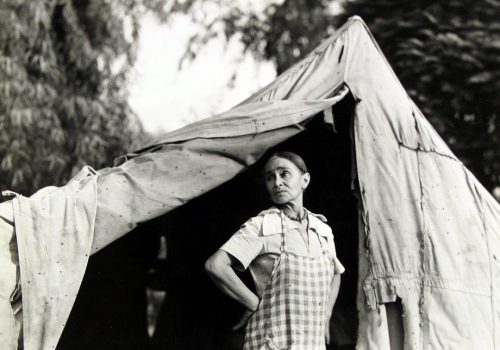Howard Greenberg Gallery was going to open two exhibitions today, but like most if not all the gallery closed temporarily because of the coronavirus.
Here is a first look, as we hope to experience soon the prints on the walls of the gallery.
A tale of two Americas, told through iconic photographs from the 1930s, is the subject of dual exhibitions at Howard Greenberg Gallery. One Third of a Nation: The Photographs of the Farm Security Administration depicts the challenges impoverished families were enduring with photographs by Dorothea Lange, Walker Evans, and Gordon Parks, among others, while Lewis Hine: The WPA National Research Project Photographs, 1936-37 portrays the workers and the innovations that spurred the nation’s economic growth. Together the exhibitions demonstrate the extraordinary power of photography to define an era and inspire social change.
As the consequences of the Great Depression, unemployment, poverty and the effects of the Dust Bowl ravaged the country in the 1930s, government programs such as the Farm Security Administration (FSA) were established. American photographers were employed to document the dire conditions. At the same time, Lewis Hine was hired by the Works Progress Administration’s (WPA) National Research Project (NRP) to show the modernizing accomplishments of the nation’s factories, in the years prior to WWII. His efforts focused on the country’s reorganized workplace that fueled industrial growth and drove out the Depression. The powerful work of these photographers under President Franklin Delano Roosevelt’s New Deal programs ushered in an unprecedented new era for the medium: across the entire nation photography was communicating what words could not.
Imbued in the nation’s social consciousness, the images that illustrate the history of the Great Depression originated in presidential action. In his second inaugural address, Roosevelt poignantly stated, “I see one-third of a nation ill-housed, ill-clad, ill-nourished. The test of our progress is not whether we add more to the abundance of those who have much; it is whether we provide enough for those who have too little.”
In establishing the Resettlement Administration in 1935 – later renamed the Farm Security Administration in 1937 – Roosevelt created a robust response to help America’s poor farmers, sharecroppers, and migrant workers. Roy Stryker, an economist, was hired to document the situation and quickly developed an extraordinary roster of young photographers.
One Third of a Nation: The Photographs of the Farm Security Administration presents more than 50 photographs by Walker Evans, Dorothea Lange, Russell Lee, Carl Mydans, Gordon Parks, David Robbins, Arthur Rothstein, Peter Sekaer, Ben Shahn, and Marion Post Wolcott. From 1935 to 1943, the photographers of the FSA shot nearly 80,000 photographs traveling the country on assignments that could last for months at a time. Their touching portraits of children, concerned parents, struggling workers, and difficult living situations are regarded as some of the finest examples of modern documentary photography. The images proved in no uncertain terms that the nation needed to act.
While the FSA photographers were working across the country, so too was Lewis Hine for a dynamic “think tank,” which included several passionate young people, who would oversee assessing the economy’s future. Established in 1935, the goal of the National Research Project was to investigate new industrial technologies and their effects on employment. As a pre-eminent pioneer of American photography, Hine was known for chronicling the unfair social conditions of his day, which led to the passage of the National Child Labor Law.
Eager to depict these new facets of technology, Hine set off to photograph factory workers in textiles, furniture, cabinet making, radio manufacturing, construction, and mining, among others, in New Hampshire, Massachusetts, New York, New Jersey, Pennsylvania, North Carolina, and West Virginia. Fueled by his belief that labor was the soul of America, Hines’s portraits depict the dignity and industriousness of the worker, offering an evocative record of America’s innovative response to the groundbreaking technologies of the time.
Lewis Hine: The WPA National Research Project Photographs, 1936-37 presents more than 70 images. It is the most comprehensive exhibition ever mounted of Hine’s NRP photographs. The exhibition was inspired by the research of photographic historian Judith Mara Gutman. She writes in her 2017 book Lewis Hine: When Innovation Was King (Steidl/Howard Greenberg Library) that “Hine produced a cross-section of American working life….[and] imbued his photographs with a singular importance that elevated them beyond the generally accepted role of photographs as illustration to text.”
More than 80 years later, the photographs from the New Deal programs of the FSA and NRP share a remarkable ability to capture the human spirit whether in spite of intolerable conditions, or in depicting ingenuity and dignity in the workaday world. Together these two exhibitions show how the medium of photography changed the trajectory of both social documentation and photographic history.
Howard Greenberg Gallery
41 East 57th Street, Suite 1406, New York.
















